Hindu mythology, alternatively called Indian mythology, involves the all-encompassing lore behind the world’s third-largest religion. As a contender for being the oldest religion in the world, Hinduism had a significant impact on some of Earth’s earliest cultures. For example, Hinduism acted as the socio-theological backbone for the Indus Valley civilization for centuries. While the religion’s influences can be seen in things such as the (controversial) caste system, Hinduism further acted to unite ancient India.
Table of Contents
What is Hindu Mythology?
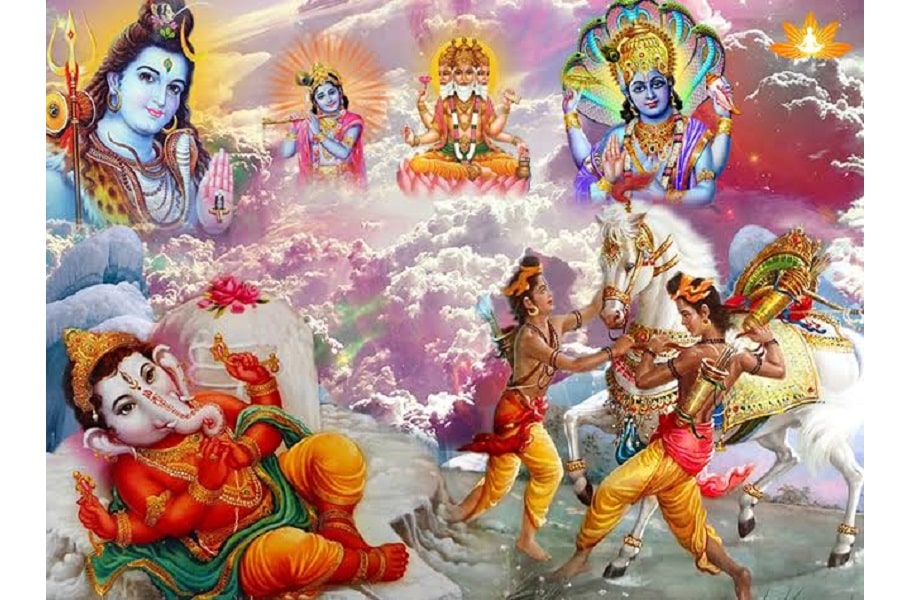
Hindu mythology is a collection of myths and legends that belong to the Hindu faith. Its iconic (and ancient) religious texts are the Vedas, the oldest Sanskrit literature in history. Altogether, Hindu mythology dates back to the 2nd millennium BCE and is believed to have originated around the Indus River.
What is the Basic Hindu Mythology?
The bare-bone basic beliefs of Hinduism include samsara (cycle of life and reincarnation) and karma (cause and effect). Hindus also believe that all living things have a soul – called an “atman” – that is part of a supreme spirit. Therefore, there are animistic principles that are found within Hinduism. The basics of Hindu mythology can be found in the four Vedas: the Rigveda, the Yajurveda, the Samaveda, and the Atharvaveda.
What is Hindu Mythology Called?
Practitioners of Hinduism have taken to calling the religion Sanātana Dharma, which denotes the religion’s primary principles and eternal truths. However, Hinduism has four major denominations: Shaivism, Shaktism, Smartism, and Vaishnavism. There are other, lesser-known sects within Hinduism as well, with their own interpretations of the mythology. On another hand, Hindu mythology has also been used interchangeably with Indian mythology.
Scholars believe that the religion originated in the Indus Valley civilization and its many cultures. The rock shelters of Bhimbetka offer insight into some of the region’s earliest societies, along with their cultural traditions and – perhaps – the threads of Hindu mythology.

READ MORE: Ancient Civilizations Timeline: The Complete List from Aboriginals to Incans
What is the Hindu Creation Myth?
In Hinduism, creation is credited to Lord Brahma. From himself, the universe came to be. He also created the dichotomy of good and evil, as well as the other devas, demons, and earthly creatures. In short, Brahma is the origin of all things.
In the Hindu creation myth, Brahma emerges from a golden egg. The existence of a gilded, cosmic egg is a motif prevalent in other world mythologies. The Brahmanda Purana goes into great detail to describe the cosmic egg and Brahma’s role in creation, along with his creation of mankind. You see, the creation of man came about when Brahma had kids with the goddess Saraswati, the Hindu goddess of knowledge.
Their (very human) son, Manu, would go on to marry the first human woman, Shatarupa, or Ananti, depending on the source. Translations get hazy, and Manu’s wife may or may not have been his sister, born at the same time as he was from Brahma alone. Together, they are the ancestors of all of humanity.
Why are There 14 Worlds in Hindu Mythology?
The 14 worlds in Hindu mythology represent varying levels of philosophical spiritual awareness, being more symbolic than anything. At least, that is the popular theory amongst theologists. The 14 realms could, honestly, just be the way the universe is divvied up per the way Hinduism developed.
In Hindu cosmology, there are 14 different worlds, or planes (lokas), which are discussed in the Atharvaveda. They are divided evenly, giving us seven upper worlds – known as the Vyahrtis – and the seven lower worlds, the Patalas. The lokas end up meeting in the middle, thus creating the earthly domain of Bhur-Loka. Major deities, such as Lord Vishnu and Lord Shiva, have their own lokas that they lord over.
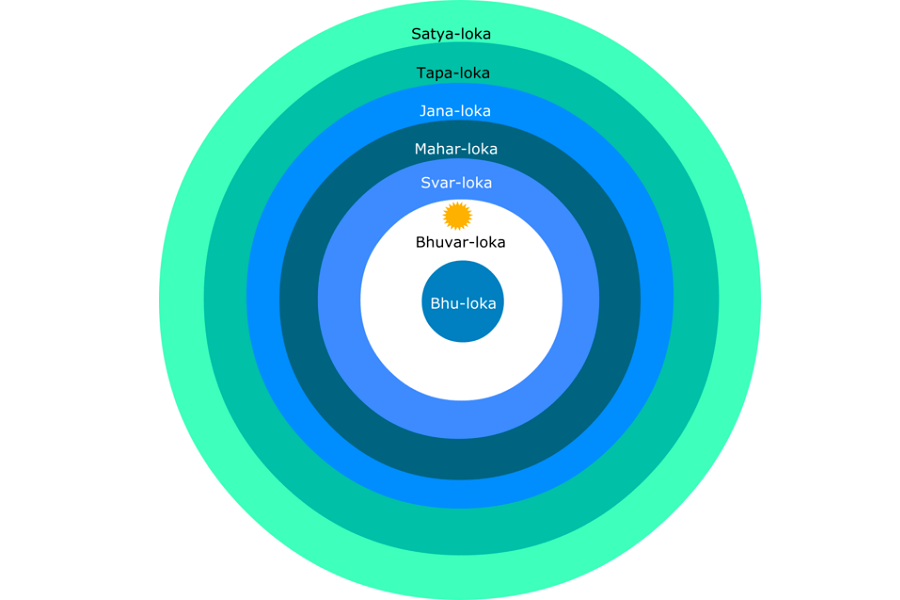
The Hindu Pantheon: Meet the Devas
Called devas, Hindu gods and goddesses are some of the oldest and most impressive divinities. Many gods have several aspects, avatars, or incarnations. These manifest in various myths and legends. Each major god has unmistakably iconography, to boot.
Hinduism and Hindu mythology are based on exuberant polytheism. There are countless devas and devis (goddesses), all of whom can influence the natural world. The Hindu pantheon is thought to be home to anywhere from 33 to 330 million gods and goddesses. It all comes down to religious texts and the different sects of Hinduism.
The most noteworthy deities include:
- Aditi
- Bhramari
- Durga
- Ganesha
- Ganga
- Hanuman
- Indrani
- Kali
- Kama
- Krishna
- Kubera
- Mahadevi
- Manasa
- Manikandan
- Murugan
- Radhu
- Rati
- Shakti*
- Shashti
- Sita
- Skanda
- Yama
- The Dashavatara – the 10 Incarnations of Vishnu
- The Mahavidya – the 10 forms of Mahadevi
- The Navadurga – the 9 forms of Durga
*Shakti is the name of a goddess and the dynamic energies that flow throughout the universe at large; “shakti” may also refer to power and/or force, though it is primarily used to define cosmic energy
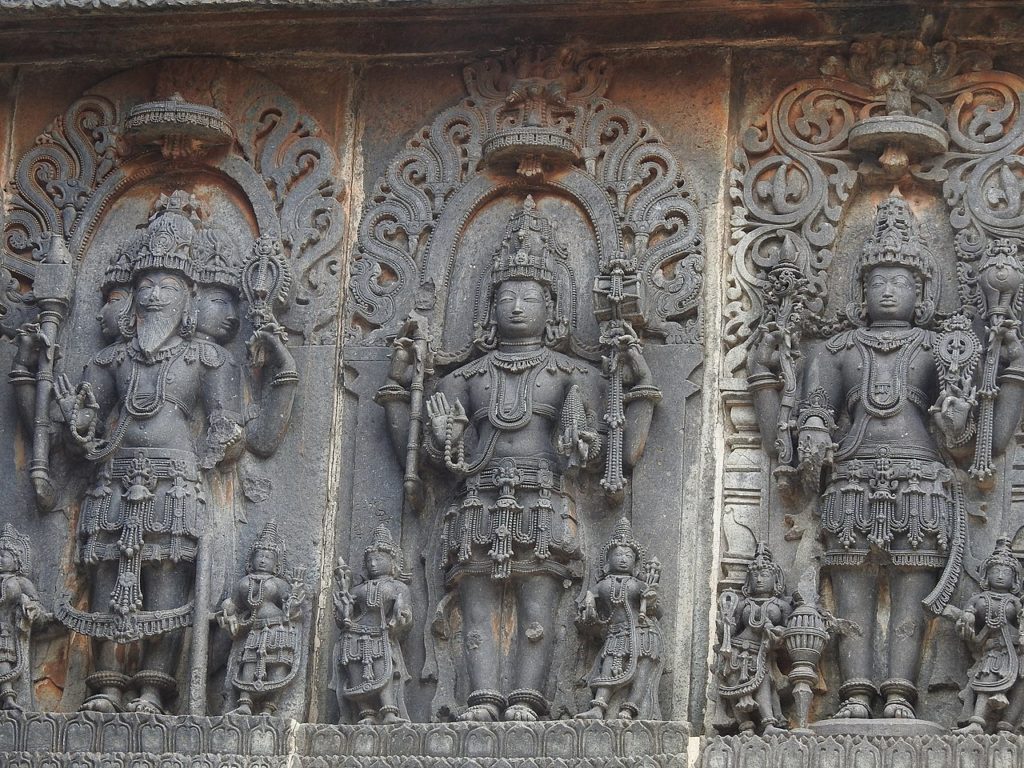
The Trayastrinshata of the Rigveda
The Trayastrinshata is a collection of 33 Hindu deities that are referred to within the Rigveda and other prominent Hindu literature. However, they are not always 33 in number, and exactly who is a member of the Trayastrinshata changes between sources. The general consensus is that the Trayastrinshata are the children of Aditi, goddess of the cosmos, and the legendary sage Kashyapa, although this lineage does vary. In Buddhism, the Trayastrinshata are known as the Trayastrimsa.
The Adityas
The Adityas are twelve gods accounted for in the Brahmanas and the Rigveda. The deities are a portion of the offspring born between the goddess Aditi and the Vedic sage Kashyapa. They uphold moral righteousness and are, more or less, perfect beings. Each member of the Adityas is meant to represent the months as they are depicted in a solar year.
- Amsha
- Aryaman
- Bhaga
- Daksha
- Indra
- Mitra
- Pushan
- Savitr
- Tvashtr
- Varuna
- Vishnu
- Vivasvat
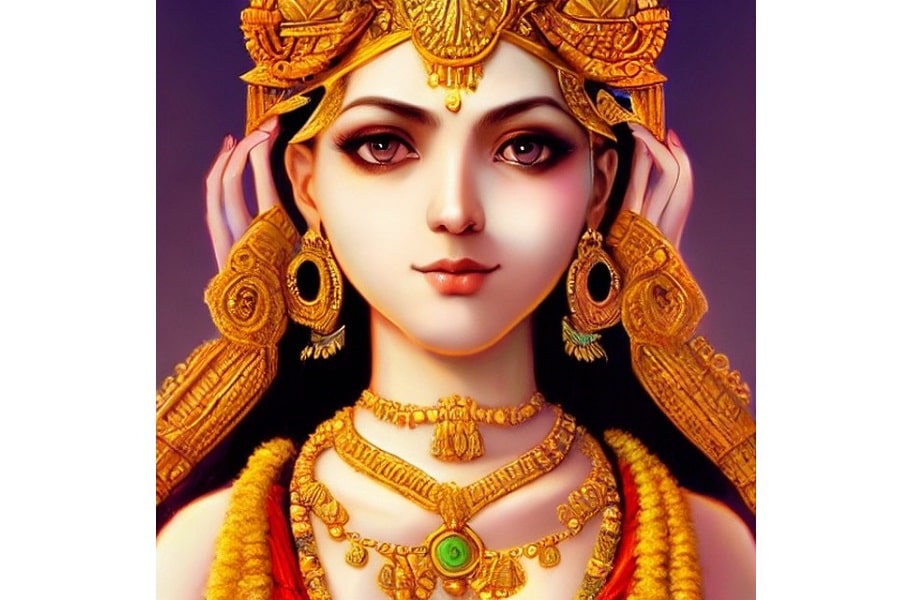
The Rudras
There are eleven Rudras, all of whom are a form of the Vedic deity, Rudra. How the Rudras came to depend on the source, with some – such as the Matsya Purana – citing their parents as the cow goddess Surabhi and Brahma. Other contenders for parents of the Rudras include the combination of Kashyapa and Surabhi, or the god of death alone, Yama. As the Hindu religion developed, Rudra became synonymous with the god Shiva.
The later Vishnu Purana describes how Shiva split into eleven separate selves while in the form of Ardhanarishvara. Thus, he created the Rudras. His other half (literally and metaphorically), Parvati, did the same and created the eleven wives of the Rudras, called the Rudranis.
The Vasus
The Vasus are eight attendants of the gods Indra and Vishnu. They embody fire, light, and heat. Rather than children of Kashyapa and Aditi, they have also been considered to be offspring of Manu or Yama and a minor goddess named Vasu.
The Ashvins
The Ashvins fulfill the divine twin facet of Hindu mythology. They are described as guardians and protectors, who swoop in on their chariots to save mortals from dire situations. Their parents are oftentimes said to be the sun god Surya and his consort, Saranyu. Unlike other members of the Trayastrinshata, the Ashvins are not known to have personal names.
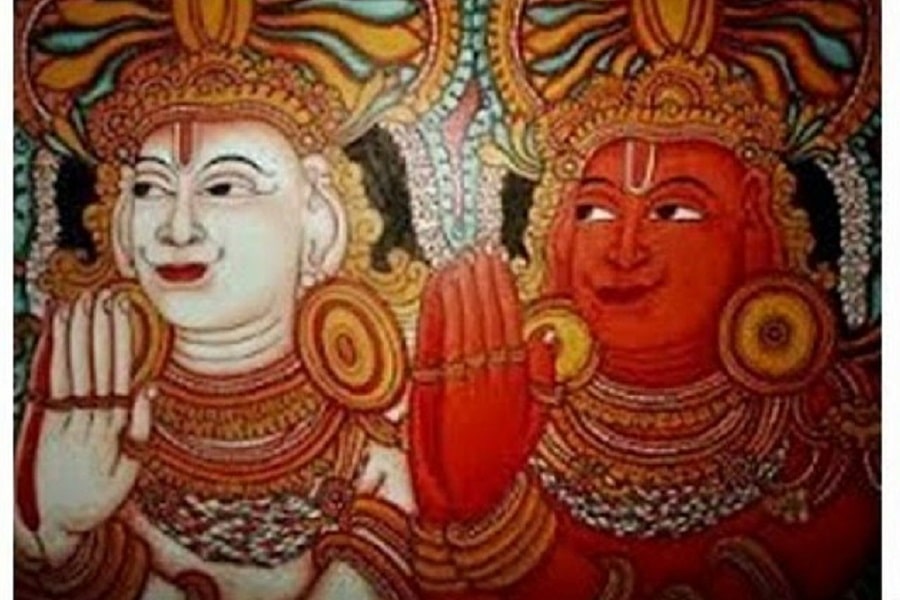
The Trimurti and the Tridevi
Within Hindu mythology, the Trimurti and Tridevi are prominent deities. Also known as the Hindu trinity, the Trimurti is the divine triad of Brahma (Creation), Vishnu (Preservation), and Shiva (Destruction). Their wives and shakti are the Tridevi. The Tridevi are considered to be the feminine aspects of the masculine Trimurti.
- Brahma
- Vishnu
- Shiva
- Saraswati
- Lakshmi
- Parvati
The Matrikas
The Matrikas are seven Hindu mother goddesses. When depicted with an eighth member, they are known as the Ashtamatrikas. Potentially archaic interpretations of the danger that could beset children before adulthood, the Matrikas became associated with fertility, childbirth, and disease. Most notably, the Matrikas evolved to be the guardians of young children and infants.
- Brahmani
- Chamunda
- Indrani
- Kaumari
- Maheshwari
- Narasimhi
- Vaishnavi
- Varahi

The Navagraha
The Navagraha are nine celestial deities that represent nine heavenly bodies: the Sun, Moon, Mercury, Venus, Mars, Jupiter, and Saturn. The Navagraha also includes the two lunar nodes. In the Hindu Middle Ages, there were only seven identified heavenly bodies and, therefore, only seven deities to represent them. Each deity was associated with a weekday.
- Surya
- Chandra
- Budha
- Shukra
- Mangala
- Brhaspati
- Shani
- Rahu
- Ketu
The Marutagana
The Marutagana were twenty to sixty storm deities. They are considered to be a part of Indra’s entourage, coming down from the north in a cacophony. Some scholars conclude that the Marutagana in the presence of Indra is the Hindu equivalent of a northern European Wild Hunt.
Who is the Indian God of Creation?
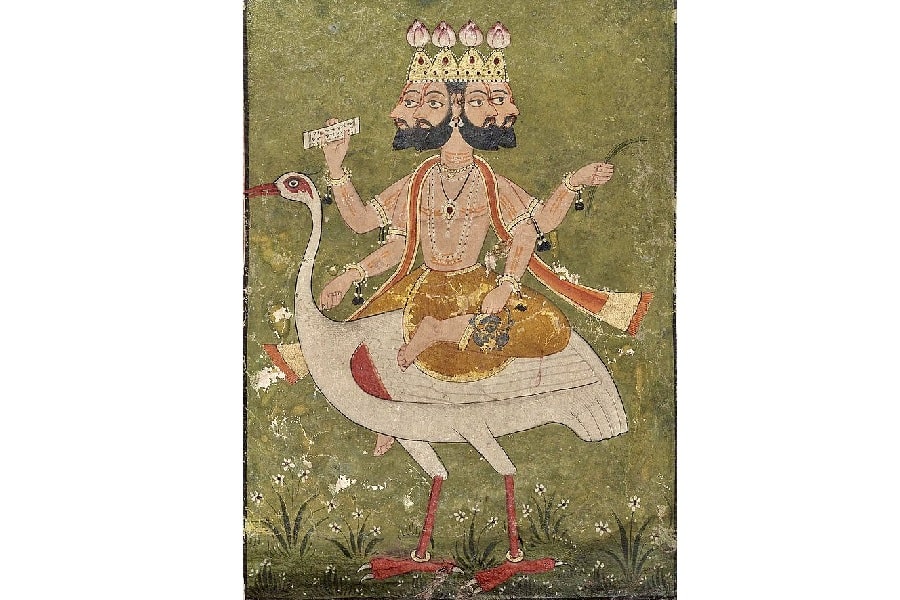
The Hindu god of creation is Brahma. As the creator of the universe itself, Brahma is a mighty god that is disconnected from popular Hindu myths. He does not toil over mortal affairs and exists more of an abstract belief than a deity.
It is thought that the lack of worship of Brahma is explained in a myth where Shiva, his brother and the “destroyer” god mutilates and curses him for developing an obsession with the first woman, Shatarupa. Otherwise, it is said that Brahma’s role ended when the world was created, and he went into an unofficial retirement – if that’s a thing gods could do. Hence, Vishnu and Shiva are still venerated because their roles are still being fulfilled.
Who is the Oldest God in Hinduism?
Brahma is the oldest god in Hinduism since he is the creator of the universe and the progenitor of all living things. Because of this, Brahma has been referred to as “grandfather” in some sects of the religion. Considering his seniority over other deities, it may be shocking to discover that the creator of all things isn’t heavily worshiped in modern Hinduism. The god of destruction, Shiva, is far more popular – especially within Hindu Shaivism traditions.
Brahma is associated with the ancient Vedic god of creation, Prajapati. As a Vedic creator deity, Prajapati could pre-date India’s Vedic Period (1500-1100 BCE) with origins in the Indus Valley civilization.
Why Do Hindu Gods Have So Many Arms?
Hindu gods have so many arms because, in short, more arms equals more power. The phenomenon of deities being presented with four arms in Hindu iconography actually has a name, chaturbhuja. Vishnu is most commonly depicted with the chaturbhuja, which is also an epithet of his, to show his supreme power over the universe.
It is safe to say that although the arms aren’t necessarily flexing, having more than two arms is undoubtedly a flex. A flex of power, that is.

Where Do Hindu Gods Live?
The Hindu gods live in Svarga, alternatively known as Svargaloka (Svarga Loka). It is one of seven higher planes (called lokas in Hinduism) in the religion’s cosmography. Svarga is described as the home of the devas, ruled over by the god Indra from its capital, Amaravati. As a realm of light and splendor, Svarga is a point of contention in the eternal conflict between the devas and the asuras.
Most deities of Hindu mythology reside within the plane of Svargaloka. Despite this, other prominent gods – namely members of the Trimurti – lord over their own respective realms. The god of death, Yama, likewise resides in and rules over his own separate plane, Naraka.
Ancient Vedic Religious Traditions and Hindu Beliefs
The Vedic religion of eld is thought to be the predecessor of present-day Hinduism. Though they have their key differences, the skeleton of Vedic practices still appears within Hindu mythology. In the Vedic religion, key gods included Indra, Agni, Soma, and Rudra, all of which appear in Hinduism. Vedic traditions also include the concept of a permanent afterlife, which challenges Hinduism’s belief in reincarnation.
Generally, it is thought that the Indian subcontinent transitioned from Vedic practices to Hinduism sometime in the sixth century BCE. This would be during the Late Vedic Period. Simultaneously, philosophical traditions began to lean into Hindu concepts, and the Vedic gods merged with newer, more unified Hindu divinities.
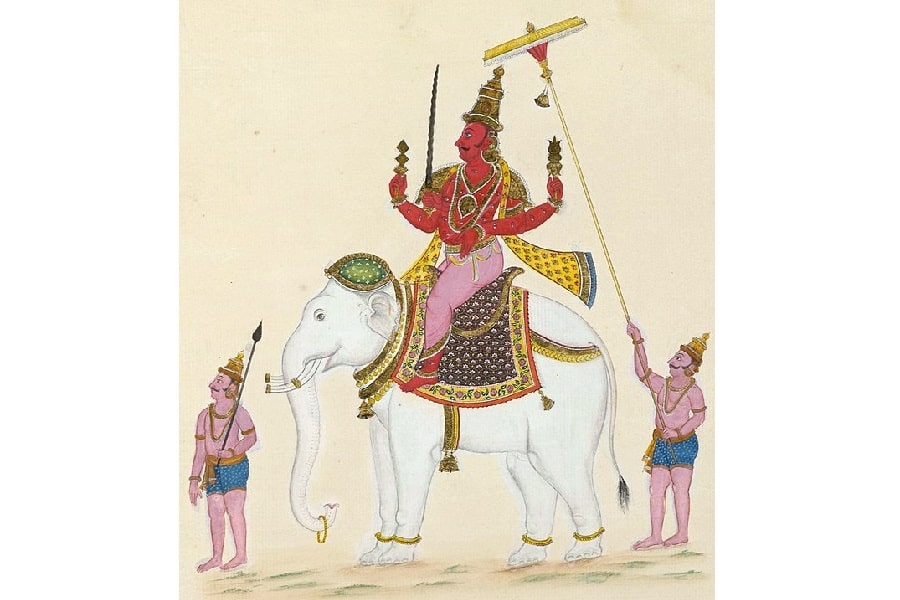
Sects and Cults
Today, there are four major sects of Hinduism: Shaivism, Shaktism, Vaishnavism, and Smartism. Although it is easy to assume these sects were founded during the modern period, all four have ancient roots. Each believes in a supreme being, though who that being is changes between sects; in Smartism, who the higher power is varies between practitioners.
Indian folk cults are just as archaic and hold dominant traditions in certain regions of the Indian subcontinent. While veneration of all the gods was standard, their worship included Yakshas and Nagas. In some states, tutelary deities took precedence over other gods. Sacred groves became abundant and nature spirits became focal points of veneration.
Traditional Sacrifices
Sacrifices have a unique place in Hinduism, with myths in the Mahabharata and other Vedic texts addressing the religious practice. Animal sacrifices (bali) are amongst the most frequent sacrifices in Hinduism, as they date back to Vedic practices recorded in the Yajurveda. There are records of a horse sacrifice, called Ashvamedha, in the “Ashvamedhika Parva” of the Mahabharata to establish a sovereign’s rule. Other animal sacrifices of cattle, oxen, goats, and deer are performed during ceremonies and festivals.
Many Hindus today are vegetarian, and bali is only performed by certain sects in some regions of India. This emerges from several later religious developments. The most influential is the 11th century CE Bhagavata Purana, wherein the god Krishna advises man to not perform animal sacrifices in the current age (Kali Yuga). Furthermore, the level of violence in bali caused the practice to become unfavorable in later periods when nonviolence became a cardinal virtue.
There is no real evidence of purushamedha, or human sacrifices, ever being performed in Hindu mythology. There’s a chance that Vedic religion called for it, but there has been no substantial evidence suggesting this. Scholars are sorely lacking both archaeological and literary evidence regarding the prevalence of purushamedha in Hinduism. The degrees of general blood sacrifices varied largely between the Vedic and Tantric Periods of India’s history.
Other sacrifices include food offerings and libations, which are given during rituals, festivals, and daily worship. The size and contents of the sacrifices offered may vary, with many facets of a sacrifice depending on the deity they are meant for.
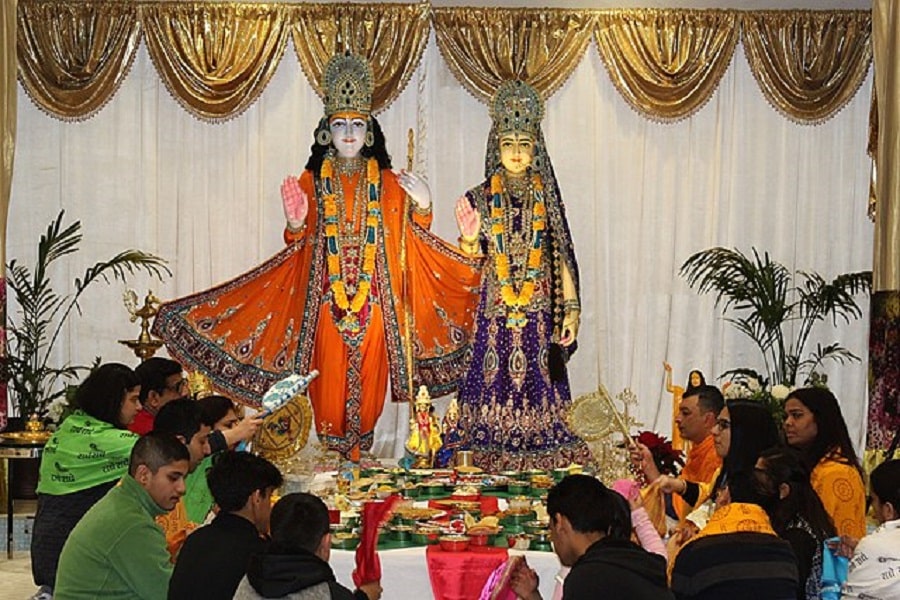
Festivals and Holidays
Many present-day Hindu festivals have ancient roots. Indeed, today’s festivals and holidays rely on the myths and legends of ancient Hindu mythology. From veneration of the gods to celebrating historical folklore, the festivals of Hinduism are as culturally rich as they are mythologically significant.
- Chhath Puja
- Diwali
- Ganesh Chaturthi
- Ghadimai Festival
- Guru Purnima
- Holi
- Krishna Janmashtami
- Lohri
- Maha Shivaratri
- Navratri
- Onam
- Rama Navami
- Ugadi
- Vasant Panchami
Legendary Heroes of Hindu Mythology
Indian mythological characters are amongst the most daring legendary heroes. Featured primarily in epic mythology and literature, the all-star heroes of Hinduism often display superhuman characteristics. To be fair, several Hindu heroes are incarnations of the gods. So, being supernatural isn’t all that far-fetched.
A majority of Hindu heroes and heroines are found in the two great epics, the Mahabharata and the Ramayana. The Bhagavata Purana is additionally counted as one of India’s great epics. Besides being explored in the longest epic poem ever written, the stories of Hindu mythology’s legendary heroes are gripping, daring, and filled with inexplicable wonder.
- Abhimanyu
- Arjuna
- Bhima
- Dronacharya
- Indrajit
- Karna
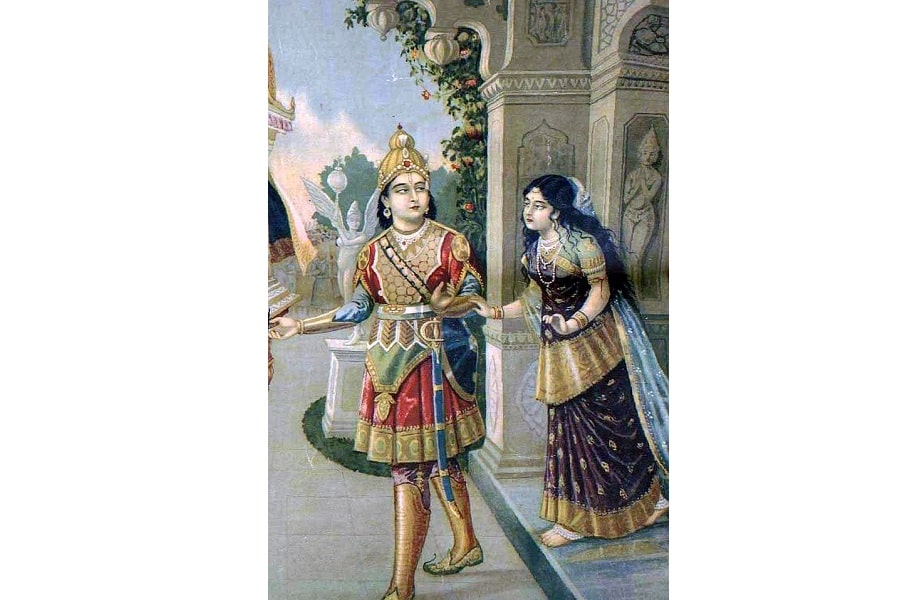
Mythological Creatures in Hindu Myths and Legends
The mythological creatures of Hindu mythology range from everything between legendary creatures, namely vahanas, to entire species of beings. Where sacred stories discuss the presence of nature spirits and malicious demons, there are also tales of sea monsters and dragons. Within Hindu mythos, mythical creatures acted as tools for the gods.
While some entities actively aided and abetted the deities’ miraculous feats, others, like the Asura, hindered them. In all, mythological creatures provided a means to an end while furthering the belief in the existence of good and evil forces in the world.
- The Asuras
- The Daityas
- Airavata, the white elephant of Indra
- The Yakshas
- Ájakava
- Bekhi
- Akupāra
- Garuda
- Shesha
- Nandi
- Nagas
- The Vanara
Dragons in Indian Mythology
In Hindu mythology, the most famous dragon is the Asura Vritra. A being of drought that hoards water instead of wealth, Vritra was created as an opponent to Indra. While other dragons are not directly named, the role of Vritra and the serpentine Nagas suggests the unique associations early Hindus had between dragons, serpents, and water.
READ MORE: Who Invented Water? History of the Water Molecule

Hindu Mythology’s Many Monsters
Where there are gods, there are bound to be monsters. The monsters of Hindu mythology represent another, darker part of the religion’s beliefs surrounding dharma. That, where there was morality and righteousness, there was immorality and spiritual corruption. Hindu monsters do not challenge the gods as much as they challenge mankind.
- Bhuta
- Kirtimukha
- Pishachas
- Rakshasa*
- Timingila
- Vetala
*A famous rakshasa is the demon king Ravana, featured in the Ramayana epic; the demon king Ravana is a quintessential Hindu villain, acting on impulse while displaying perpetual ignorance through his actions
Mythical Items found in Hindu Mythology
The mythical items of Hinduism have a range. There’s an elixir of immortality sitting right next to…a celestial missile? Three celestial missiles?! Anyways, which items played an important role in the legends of Hinduism depended on their proximity to the gods.
Items were both personal artifacts and gifts, bequeathed to those deemed worthy. Alternatively, some of the most well-known items in Hindu mythology were legendary plants. These plants could do anything from producing powerful poisons to granting any wish. Although all of the above are considered to have mythical origins, it is thought that some fantastical foliage could be found in nature.
- Ajagava
- Amrita
- Brahmastra
- Kalakuta
- Kalpavriksha
- Narayanastra
- Parijata
- Pashupatastra
- Vajra
- Varunastra
Hindu Mythology in Literary Works
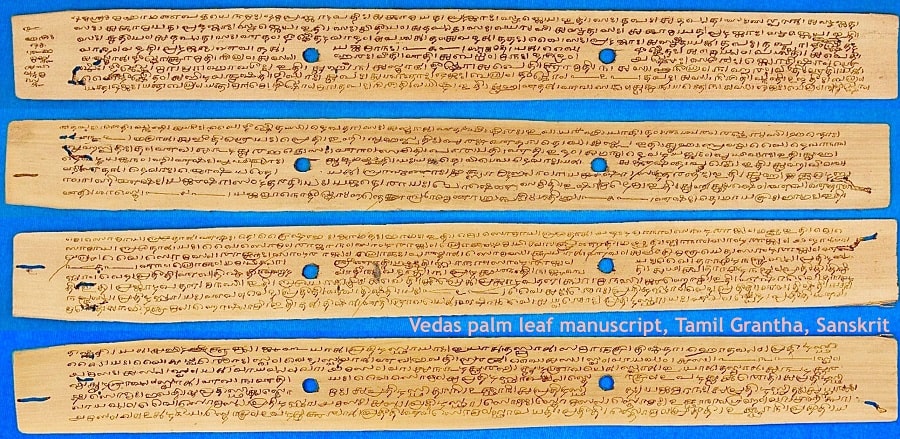
The most famous literary works that are attributed to Hindu mythology are the four Vedas, which are amongst the religion’s most known texts. There are also the Puranas, with major Puranic texts including Shiva Purana and Padma Purana. Additionally, the two great Hindu epics are the Ramayana and the Mahabharata. Overall, some of the most significant literary works that pertain to Hindu mythology are ancient texts that date to the Vedic Period.
Literature is the backbone of most world belief systems. The most popular religions in the world (i.e. Hinduism, Buddhism, Islam, Christianity, etc.) still refer to ancient texts. Moreover, religious doctrines are fantastic sources for locating earlier myths that are otherwise lesser known.
- The Bhagavad Gita
- The Upanishads
- Sangam (Tamil) Literature
Which God is Important to the Hindu Epics?
Vishnu is the most important god in the Hindu epics, the Mahabharata and the Ramayana. He is the “preserver” god of the Trimurti and therefore acts as a divine judge to quell disagreements. In either epic, the god Vishnu’s avatars are central characters.
Within the Ramayana, the seventh incarnation of Vishnu, Lord Rama, acts as the epic’s protagonist. He is the ideal man and a glorious king, on a journey to save his wife, Sita, from the morally corrupt Ravana. Otherwise, his eighth incarnation, Lord Krishna, acts as a divine advisor to the character Arjuna throughout the legendary Kurukshetra War of the Bhagavad Gita in the Mahabharata. Both incarnations are major deities in their own right, especially in Vaishnavism.
Famous Artwork that Captures Hindu Mythology
Artwork depicting Hindu mythology is found most commonly in temples and architecture. There are votive lingas, auspicious imagery, and niches that show the gods in their many forms or achieving their most courageous feats. Art was created with a conscious effort to capture the gods at their greatest, thereby honoring them further.
The most compelling aspect of Hindu artwork is the presence of mudras. Mudras are found in Hindu, Buddhist, and Jain art. As a type of iconography, mudras are symbolic gestures or poses. They are prevalent in some forms of yoga, traditional folk dance, and religious rituals.

Hindu Mythology in Film and Television
In India, Bollywood is the major film industry, and Bollywood films have an unmistakable charm. Bollywood has done the most justice for Hindu mythology through film and television. Films that delve into Hindu legends, from the Ramayana to the tale of Ashwatthama include:
- Adipurush
- Raavan
- Mayabazar
- Arjun: The Warrior Prince
- Sita Swayamvar